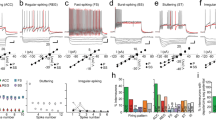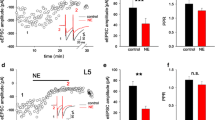Abstract
We examined whether the NMDA class of excitatory amino acid receptors contribute to synaptic transmission in the pathway connecting the medial geniculate body (MGB) with the lateral nucleus of the amygdala (LA) using extracellular single unit recordings and microiontophoresis. Cells were identified in LA on the basis of responsivity to electrical stimulation of the MGB. For each cell, a level of current was found for the iontophoretic ejection of the NMDA antagonist AP5 that blocked responses elicited by iontophoresis of NMDA, but had no effect on responses elicited by AMPA. Iontophoresis of AP5 with this level of current blocked the excitatory response elicited by MGB stimulation in most cells tested. Microinfusion of AP5 (25, 50, or 100 μM) also blocked the responses. Additional studies tested individual cells with both AP5 and the AMPA antagonist CNQX and showed that blockade of either NMDA or AMPA receptors interferes with synaptic transmission. Finally, iontophoretic ejection of either AP5 or CNQX blocked short-latency (<25 ms) responses elicited in LA by peripheral auditory stimulation. Together, these results suggest that the synaptic evocation of action potentials in the thalamo-amygdala pathway depends on both NMDA and non-NMDA receptors. We hypothesize that non-NMDA receptors are most likely required to depolarize the cell sufficiently to remove the blockade of NMDA channels by magnesium and NMDA receptors are required to further depolarize the membrane to the level required for action potential generation.
Similar content being viewed by others
References
Akaoka H, Saunier CF, Levet PY, Chouvet G (1987) Electrophysiological effects of local administration of apomorphine in the rat substantia nigra zona compacta. Neuroscience 22: [Suppl] S351
Armstrong-James M (1989) NMDA and non-NMDA neurotransmission in the construction of receptive fields of rat barrelfield neurones. Soc Neurosci Abstr 15: 949
Armstrong-James M, Callahan WE (1993) The contribution of NMDA and non-NMDA receptors to fast and slow transmission of sensory information in the Rat SI barrel cortex. J Neurosci 13: 2149–2160
Bliss TVP, Collingridge GL (1993) A synaptic model of memory: long-term potentiation in the hippocampus. Nature 361: 31–39
Bordi F, LeDoux JE (1992) Sensory tuning beyond the sensory system: an initial analysis of auditory responses properties of neurons in the lateral amygdaloid nucleus and overlying areas of the striatum. J Neurosci 12(7): 2493–3503
Bordi F, LeDoux JE (1994a) Response properties of single units in areas of rat auditory thalamus that project to the amygdala. Iacoustic discharge patterns and frequency receptive fields. Exp Brain Res 98: 261–274
Bordi F, LeDoux JE (1994b) Response properties of single units in areas of rat auditory thalamus that project to the amygdala. IICells receiving convergent auditory and somatosensory inputs and cells antidromically activated by amygdala stimulation. Exp Brain Res 98: 275–286
Brown TH, Chapman PF, Kairiss EW, Keeman CL (1988) Longterm synaptic potentiation. Science 242: 724–728
Campeau S, Miserndino MJD, Davis M (1992) Intra-amygdala infusion of the N-Methyl-d-aspartate receptor antagonist AP5 blocks acquisition but not expression of fear-potentiated startle to an auditory conditioned stimulus. Behav Neurosci 106: 569–574
Carlsen J, Heimer L (1988) The basolateral amygdaloid complex as a cortical-like structure. Brain Res 441: 377–380
Chapman PF, Bellavance LL (1992) Induction of long-term potentiation in the basolateral amygdala does not depend on NMDA receptor activation. Synapse 11: 310–318
Chiang C, Aston-Jones G (1993) A 5-hydroxytryptamine2 agonist augments γ-aminobutyric acid and excitatory amino acid inputs to noradrenergic locus coeruleus neurons. Neuroscience 54: 409–420
Clugnet MC, LeDoux JE, Morrison SF (1990) Unit responses evoked in the amygdala andstriatum by electrical stimulation of the medical geniculate body. J Neurosci 10(4): 1055–1061
Collingridge GL, Bliss TVP (1987) NMDA receptors — their role in long-term potentiation. Trends Neurosci 10: 288–293
Collingridge GL, Lester RAJ (1989) Excitatory amino acid receptors in the vertebrate central nervous system. Pharmacol Rev 40: 145–210
Cotman CW, Monaghan DT, Ganong AH (1988) Excitatory amino acid neurotransmission: NMDA receptors and Hebb-type synaptic plasticity. Annu Rev Neurosci 11: 61–80
Davies J, Watkins JC (1983) Role of excitatory amino acid receptors in mono-and polysynaptic excitation in the cat spinal cord. Exp Brain Res 49: 280–290
Davies J, Miller AJ, Sheardown MJ (1986) Amino acid receptor mediated excitatory synaptic transmission in the cat red nucleus. J Physiol (Lond) 376: 13–20
Ennis M, Aston-Jones G, Shiekhattar R (1992) Activation of locus coeruleus neurons by nucleus paragigantocellularis or noxious sensory stimulation is mediated by intracoerulear excitatory amino acid neurotransmission. Brain Res 598: 185–195
Fanselow MS, Kim JJ (1994) Acquisition of contextual pavlovian fear conditioning is blocked by application of an NMDA receptor antagonist d, l-2-amino-5-phosphonovaleric acid to basolateral amygdala. Behav Neurosci 108(1): 3–10
Farb CR, Aoki C, Milner T, Kaneko T, LeDoux JE (1992) Glutamate immunoreactive terminals in the lateral amygdaloid nucleus: a possible substrate for emotional memory. Brain Res 539: 145–158
Fox K, Armstrong-James M (1989) The location and function of NMDA receptors in cat and kitten visual cortex. J Neurosci 9: 2443–2454
Gean P-W, Chang F-C (1992) Pharacological characterization of excitatory synaptic potentials in rat basolateral amygdaloid neurons. Synapse 11: 1–9
Gean P-W, Chang F-C, Hung C-R (1993) Use-dependent modification of a slow NMDA receptor-mediated synaptic potential in rat amygdala slices. J Neurosci Res 34: 635–641
Hablitz JJ, Langmoen IA (1986). N-Methyl-d-aspartate receptor antagonists reduce synaptic excitation in the hippocampus. J Neurosci 6: 102–106
Jeftinja S (1989) Excitatory transmission in the dorsal horn is in part mediates through AP5-sensitive NMDA receptor. Neurosci Lett 96: 191–196
Jones KA, Baughman RW (1988) NMDA and non-NMDA components of excitatory synaptic potentials recorded from cells in layer V of rat visual cortex. J Neurosci 8: 3522–3534
Kim M, McGaugh JL (1992) Effects of intra-amygdala injections of NMDA receptor antagonists on acquisition and retention of inhibitory avoidance. Brain Res 585: 35–48
Kudo M, Glendenning KK, Forst SB, Masterson RS (1986) Origin of mammalian thalamocorital projections. I. Telencephalic projection of the medial geniculate body in the opossum (Didelphis virginiana). J Comp Neurol 245: 176–197
LeDoux JE (1990) Information flow from sensation to emotion: plasticity in the neural computation of stimulus value. In: Gabriel M, Moore J (eds) Learning and computational neurocience. Bradfort/MIT Press, Cambridge, Mass, pp 3–51
LeDoux JE (1992) Emotion and the amygdala. In: Aggleton J (eds) The amygdala: neurobiological aspects of emotion, memory and mental dysfunction. Wiley-Liss, New York, pp 339–351
LeDoux JE, Farb C, Ruggiero DA (1990a) Topographic organization of neurones in the acoustic thalamus that project to the amygadala. J Neurosci 10: 1043–1054
LeDoux JF, Farb CR (1991) Neurons of the acoustic thalamus that project to the amygdala contain glutamate. Neurosci Lett 134: 145–149
LeDoux JE, Farb C, Milner TA (1991) Ultrastructure and synaptic associations of auditory thalamo-amygdala projection in the rat. Exp Brain Res 85: 577–586
Lynch G (1986) Synapses, circuits, and the beginnings of memory. MIT Press, Cambridge, Mass
Madison DV, Malenka RC, Nicoll, RA (1991). Mechanisms underlying long-term potentiation of synaptic transmission. Annu Rev Neurosci 14: 379–397
Malenka RC, Nicoll RA (1993) NMDA-receptor-dependent synaptic plasticity: multiple forms and mechanisms. Trends Neurosci 16: 521–527
Mayer ML, Westbrook GL (1987) The physiology of excitatory amino acids in the vertebrate central neurons system. Prog Neurobiol 28: 197–276
McDonald AJ (1984) Neuronal organization of the Lateral and Basolateral Amygdaloid nuclei in the rat. J Comp Neurol 222: 589–606
McNaughton BL, Barnes CA (1990) From cooperative synaptic enhancement to associative memory: bridging the abyss. Semin Neurosci 2: 403–416
Miller KD, Chapman B, Stryker MP (1989) Visual responses in adult cat visual cortex depend on N-methyl-d-aspartate receptors. J Neurosci 5: 2909–2919
Miserendino MJD, Sananes CB, Melia KR, Davis M (1990) Blocking of acquisition but not expression of conditioned fearpotentiated startle by NMDA antagonists in the amygdala. Nature 345: 716–718
Monaghan DT, Bridges RJ, Cotman CW (1989) The excitatory amino acid receptors: Their classes, pharmacology, and distinct properties in the function of the central nervous system. Annu Rev Pharmacol Toxicol 29: 365–402
Nowak L, Bregestovski P, Ascher P, Herbert A, Prochiantz A (1984) Magnesium gates glutamate-activated channels in the mouse central neurones. Nature 307: 462–465
Radhakrishnan V, Henry JL (1993) Excitatory amino acid receptor mediation of sensory inputs to functionally identified dorsal horn neurons in cat spinal cord. Neurosci 55: 531–544
Rainnie DG, Asprodini EK, Shinnck-Gallagher P (1991) Excitatory transmission in the basolateral amygdala. J Neurophysiol 66(3): 986–998
Romanski LM, LeDoux JE (1992a) Bilateral destruction of neocortical and perirhinal projection targets of the acoustic thalamus does not disrupt auditory fear conditioning. Neurosci Lett142: 228–232
Romanski LM, LeDoux JE (1992b) Equipotentiality of thalamoamygdala and thalamo-cortico-amygdala circuits in auditory fear conditioning. J Neurosci 12: 4501–4509
Romanski LM, LeDoux LE (1993a) Organization of rodent auditory cortex: Anterograde transport of PHA-L from MGv to temporal neocortex. Cereb Cortex 3: 499–514
Romanski LM, LeDoux JE (1993b) Information cascade from primary auditory cortex to the amygdala: Corticocortical and corticoamygdaloid projections of temporal cortex in the rat. Cereb Cortex 3: 515–532
Romanski LM, Clugnet MC, Bordi F, LeDoux JE (1993) Somatosensory and auditory convergence in the lateral nucleus of the amygdala. Behav Neurosci 107(3): 444–450
Shiekhattar R, Aston-Jones G, Chiang C (1991) Local Infusion of calcium-free solutions in vivo activates locus coeruleus neurons. Brain Res Bull 27: 5–12
Shiekhattar R, Aston-Jones G (1992) NMDA-receptor-mediated sensory responses of brain noradrenergic neurons are suppressed by in vivo concentrations of extracellular magnesium. Synapse 10: 103–109
Staubli U (1995) Brain and memory: modulation and mediation of neuroplasticity. Parallel properties of LTP and memory. Oxford University Press, New York, pp 303–318
Stone TW (1985) Microiontophoresis and pressure ejection. St. Edmundsbury Press, Bury St. Edmunds, UK
Sugita S, Johnson SW, North RA (1992) Synaptic inputs to GABAA and GABAB receptors originate from discrete afferent neurons. Neurosci Lett 134: 207–211
Tanabe Y, Masu M, Ishii T (1992) A family of metabotrophic glutamate receptors. Neuron 8: 169–179
Thomson AM (1986) A magnesium-sensitive post-synaptic potential in rat cerebral cortex resembles neuronal responses to N-methylaspartate. J Physiol (Lond) 370: 531–549
Thomson AM, West DC, Lodge D (1985) An N-methylaspartate receptor-mediated synapse in rat cerebral cortex: a site of action of ketamine? Nature 313: 479–481
Thomson AM, Girdlestone D, West DC (1989) A local circuit neocortical synapse that operates via both NMDA and nonNMDA receptors. Br J Pharmacol 96: 406–408
Tsumoto T (1990) Excitatory amino acid transmitters and their receptors in neural circuits of the cerebral neocortex. Neurosci Res 9: 79–102
Wang YT, Bieger D, Neuman RS (1991) Activation of NMDA receptors is necessary for fast information transfer at brainstem vagal motoneurons. Brain Res 567: 260–266
Washburn MS, Moises HC (1992) Muscarinic responses of rat basolateral amygdaloid neurons recorded in vitro. J Physiol (Lond) 449: 121–154
Author information
Authors and Affiliations
Rights and permissions
About this article
Cite this article
Li, X.F., Phillips, R. & LeDoux, J.E. NMDA and non-NMDA receptors contribute to synaptic transmission between the medial geniculate body and the lateral nucleus of the amygdala. Exp Brain Res 105, 87–100 (1995). https://doi.org/10.1007/BF00242185
Received:
Accepted:
Issue Date:
DOI: https://doi.org/10.1007/BF00242185




